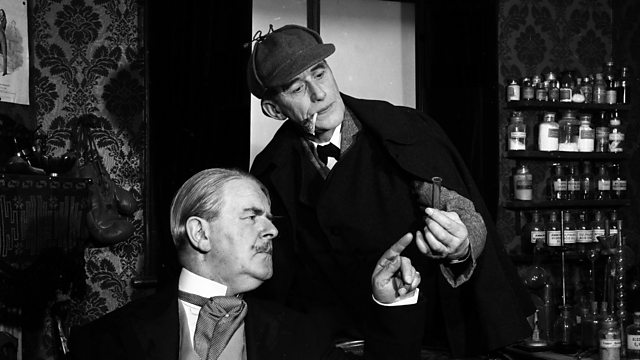The
lockdown has put paid to a number of planned 'Sojourns' (but allowed
me to plan even more – look out for ones to the Home Counties,
Wales and Devon hopefully in the next year), but following my mention
in dispatches (Peter Blau's 'Scuttlebutt
from the Spermaceti Press'
[June
2020])
for my trip to Dorsington, I decided to undertake one close to home.
In June 1891, at the age of 32, Arthur Conan Doyle moved from London
to a house in South Norwood, at that time part of Surrey.
My
starting point was Cross Street, a short walk from East Croydon
railway station. It
was in a house here that Susan Cushing (and previously her sister
Sarah Cushing) lived, where the titular cardboard box containing two
severed ears preserved in salt were sent. ['The
Adventure of the Cardboard Box']
Finding that #32 claimed to date to c1838, I chose this as the
Cushing residence.
From
here, it was a half-hour walk to Conan Doyle's former home, passing first the school where my own 'Doctor Watson' met his 'Mary Morstan', then a
cul-de-sac named after Holmes' faithful companion.
Following
the success of the first five ‘Sherlock Holmes’ short stories in
The Strand Magazine, Conan Doyle had abandoned medicine and decided
to devote himself entirely to writing. He decided to move to the
suburbs, a comfortable red-bricked house at 12 Tennison Road, South
Norwood, where he completed ‘The
Man With the Twisted Lip’,
before renewing his contract for six additional stories at the rate
of one per month. Throughout the three years he lived there, he was
not only busy with local affairs and with his writing, but also away
elsewhere in England and also abroad on business much of the time. It
was also a traumatic time for him and his family, for in the same
month his alcoholic father died, and his wife Louise was diagnosed
with consumption. His wife's declining health appears to have been
the main factor in a decision to leave the area, and in September
1894 he left for the United States on a tour of speaking engagements.
By this time the house had been put up for sale, and on returning to
England he and Louise settled at their purpose-built home, Undershaw
in Haslemere, having spent much of the previous year in Switzerland
for Touie’s health.
The
house has a plaque.
A
further fifteen minute walk, passing a road with a familiar name, and
a housing development named after Mr. Holmes' most famous case, I
found myself at Norwood Junction railway station.
It
would have been from Norwood Junction station that Jonas Oldacre travelled up to
London Bridge Station, prior to meeting with (the unhappy) John
Hector McFarlane, in 'The Adventure of the Norwood Builder'.
During this journey, he drew up the will that he wished McFarlane to
'cast it into proper legal shape'. Holmes later deduced this from the
state of the handwriting – the good writing representing stations,
the bad writing movement, and the very bad writing passing over
points.
A
short distance away was 83-84 Norwood High Street, where Norwood
Police Station - where Thaddeus Sholto reported the murder of his
brother in 'The Sign of Four'
- was formerly located. By chance, Scotland Yarder, Inspector
Athelney Jones, was at the station investigating another case, and
accompanied Sholto and the local force back to Pondicherry Lodge,
renewing his acquaintance with Holmes.
I then caught a bus to
Upper Norwood where a school with a familiar name was located. This
'Priory School' was not the one attended by Lord Saltire in 'The Adventure of the Priory School', which was located in the North of
England (possibly Staffordshire).
A further short bus
ride and walk up a very steep hill, and I was at my penultimate stop
of the day, ‘Kilravock House’ (101 Ross Road) in South Norwood.
It was here, according to noted Sherlockian Roger Johnson, that
Pondicherry Lodge - where Holmes, Watson, Mary Morstan and Thaddeus
Sholto travelled to meet with Bartholomew Sholto in 'The Sign of
Four', only to find that he had been killed and the great Agra
Treasure stolen from the attic room – was located.
I then caught a bus
back into central Croydon, where due to the pandemic, the Museum of
Croydon in the Clocktower, which was supposed to be hosting a
'Storytellers' exhibition, was closed. Luckily I had managed to
visit the exhibition, which included a section on Conan Doyle and
Sherlock Holmes and their Croydon connections (including the ear-containing cardboard box), prior to lockdown.
It was then one to my
final stop, a Public House also named after Sherlock's most famous
case, which I decided not to go into, before catching the bus home.
Postcript: There is
another Sherlockian link to Croydon. Peter Cushing who played Holmes
on both film and TV lived at 32 St James’ Road in nearby Purley
from about 1925 until June 1936, during which time he attended nearby
Purley County Secondary School and worked at the local council. In
2018 a plaque was erected to commemorate this, which again I have
visited on a previous occasion.






























